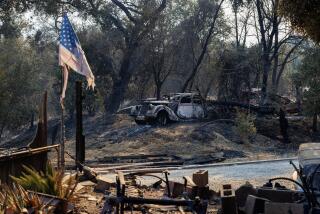Boeing Must Find Source of Contaminant
A state regulatory agency has detected unsafe levels of a contaminant used in rocket fuel in a well about a mile from Boeing’s Rocketdyne testing site in the Santa Susana Mountains, officials said Wednesday.
Because of the recent discovery of perchlorate downhill from the mountaintop laboratory, Boeing has been ordered to conduct extensive water and soil tests at the well to determine the contamination’s source, said Gerard Abrams, geologist and project director for the Department of Toxic Substances Control.
“We think it’s essential to help us understand how perchlorate arrived at this well,” Abrams said. “It will help us to understand what happened down in Simi Valley.”
The state agency has given the aerospace giant an Aug. 18 deadline to come up with a plan to determine if the contamination on property owned by the Brandeis-Bardin Institute came from the Santa Susana Field Laboratory, Abrams said Wednesday in a briefing at the agency’s offices in Glendale.
The action is significant because Boeing has argued for years that it is not the cause of off-site contamination. If Rocketdyne is found to be the source, Boeing could be liable for millions of dollars in cleanup costs -- on top of millions it is already spending to rid the former nuclear research and rocket-testing laboratory of toxic chemicals.
Boeing spokeswoman Blythe Jameson said company officials were surprised by the action, especially since recent tests of wells located between the lab and Brandeis came up negative for perchlorate. What’s more, a test of the Brandeis well a year ago also was negative, she said.
“We’ll be looking at all the data carefully,” Jameson said. “We are responsible neighbors and we will take whatever steps are necessary to alleviate their concerns about this latest finding.”
The state agency’s announcement is the latest development in an ongoing search for the source of perchlorate contamination in Simi Valley, where the chemical has been found at unsafe levels in wells scattered throughout the city. So far, the findings have confounded scientists because they have not pointed to any particular source or path, Abrams said.
“The recent detection of perchlorate ... suggests that the contamination from SSFL may have migrated off-site to the Brandeis-Bardin property,” the agency wrote in its order Monday. “The presence of other or contributing sources of perchlorate, beyond those identified at SSFL, is unlikely.”
Although the federal Environmental Protection Agency has established that perchlorate in drinking water in any amount higher than 1 part per billion is unsafe for human consumption, California health officials have set a safety standard of 4 parts per billion.
One part per billion is roughly equivalent to one drop of water in a home swimming pool, according to the Metropolitan Water District of Southern California.
Perchlorate has been found in concentrations as high as 1,600 ppb at the field lab, specifically in an area known as Happy Valley, where perchlorate was stored for rocket-making. Happy Valley is two miles from the Brandeis well.
The amount of perchlorate found at the well was measured at 140 ppb and 150 ppb on May 30. A second test conducted June 11 showed perchlorate levels of 39 ppb and 36 ppb, Abrams said.
Horses and other wildlife drink from the well on the bucolic, 3,000-acre property that houses a Jewish studies center where adults and children participate in educational programs. The well is fenced off in a remote area, said Ivan Wolkind, director of operations for the institute.
“Luckily, that well is never used,” Wolkind said Wednesday. “It’s just a pipe that runs straight into the ground and releases a drop of water about every four seconds. It’s like a leaky faucet.”
The state agency was first alerted to perchlorate contamination at the well by the Ventura County Public Health Services which conducted a routine test Feb. 21 that measured a level of 82 ppb.
Although Simi Valley drinking water comes from Northern California, the imported water is mixed with water from two wells in the city. No perchlorate has been detected in those two wells, said David Bacharowski, assistant executive officer for the California Regional Water Quality Control Board.
The Brandeis well is about three miles from the mixing wells.
Tests of samples taken at three other wells on the Brandeis property revealed perchlorate levels below 3 ppb, Abrams said. All four wells tested negative for other types of toxic substances.
Perchlorate, a salt used as an oxidizer in highway flares and air bags as well as in missiles and other munitions, can interfere with thyroid function. It can affect early brain development and cause tumors. State and federal health officials now believe that, even in tiny amounts, the chemical may cause health problems, especially among pregnant women and young children.
In Simi Valley, perchlorate also was found for the first time in water seeping from the ground on two residential streets three to four miles from Rocketdyne, Abrams said. They showed a concentration of 4.1 ppb in water samples taken from Caballero Street and 4.8 ppb from Wallace Street.
“It’s tough when you get the low concentrations,” Bacharowski said. “It’s hard to know what it actually means. It’s not clear what the source is.”
As for the Boeing investigation, Abrams said the company will be required to install new wells and retrofit existing wells to help determine the perchlorate migration pattern.
Boeing also will have to conduct such activities as geologic mapping, aerial photography, a review of hydrology data, well monitoring and aquifer testing.
The company also will likely be required to clean up the perchlorate that is already in the well or at least contain it, he said.
More to Read
Inside the business of entertainment
The Wide Shot brings you news, analysis and insights on everything from streaming wars to production — and what it all means for the future.
You may occasionally receive promotional content from the Los Angeles Times.










